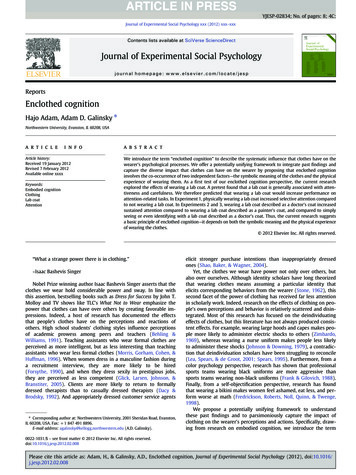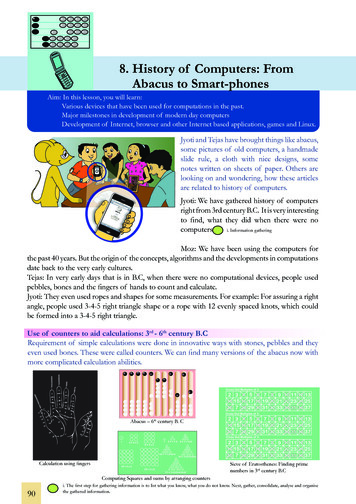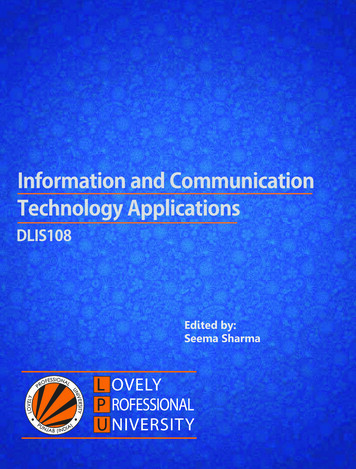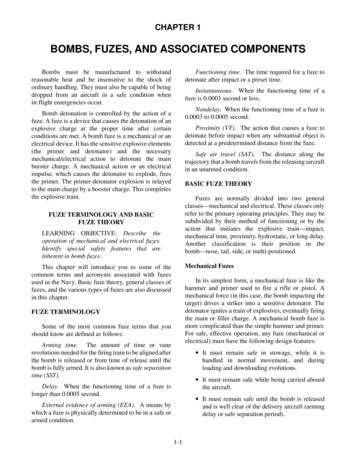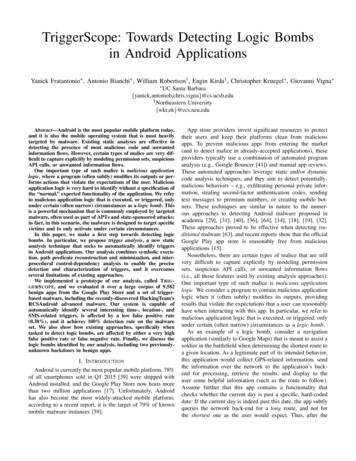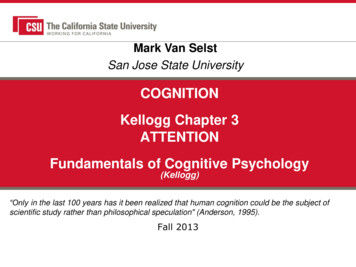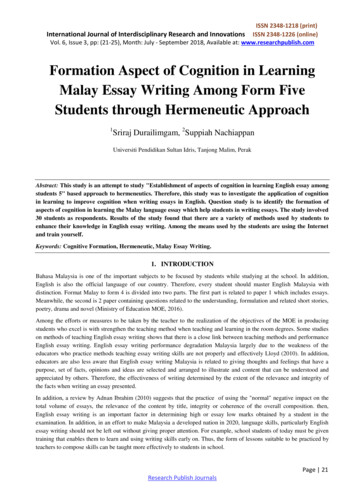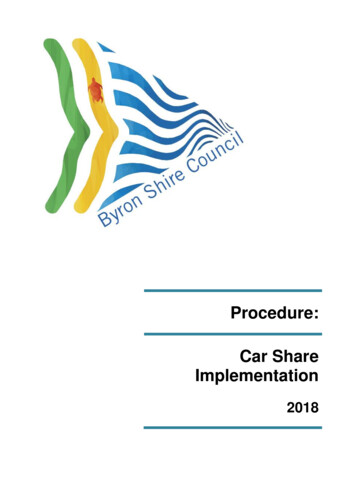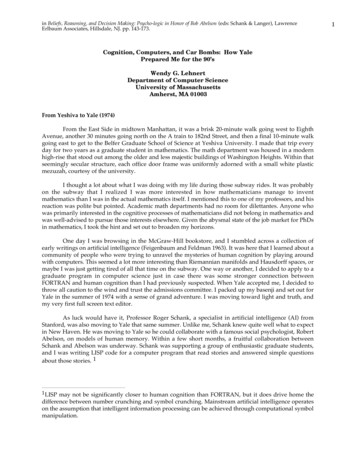
Transcription
in Beliefs, Reasoning, and Decision Making: Psycho-logic in Honor of Bob Abelson (eds: Schank & Langer), LawrenceErlbaum Associates, Hillsdale, NJ. pp. 143-173.Cognition, Computers, and Car Bombs: How YalePrepared Me for the 90’sWendy G. LehnertDepartment of Computer ScienceUniversity of MassachusettsAmherst, MA 01003From Yeshiva to Yale (1974)From the East Side in midtown Manhattan, it was a brisk 20-minute walk going west to EighthAvenue, another 30 minutes going north on the A train to 182nd Street, and then a final 10-minute walkgoing east to get to the Belfer Graduate School of Science at Yeshiva University. I made that trip everyday for two years as a graduate student in mathematics. The math department was housed in a modernhigh-rise that stood out among the older and less majestic buildings of Washington Heights. Within thatseemingly secular structure, each office door frame was uniformly adorned with a small white plasticmezuzah, courtesy of the university.I thought a lot about what I was doing with my life during those subway rides. It was probablyon the subway that I realized I was more interested in how mathematicians manage to inventmathematics than I was in the actual mathematics itself. I mentioned this to one of my professors, and hisreaction was polite but pointed. Academic math departments had no room for dilettantes. Anyone whowas primarily interested in the cognitive processes of mathematicians did not belong in mathematics andwas well-advised to pursue those interests elsewhere. Given the abysmal state of the job market for PhDsin mathematics, I took the hint and set out to broaden my horizons.One day I was browsing in the McGraw-Hill bookstore, and I stumbled across a collection ofearly writings on artificial intelligence (Feigenbaum and Feldman 1963). It was here that I learned about acommunity of people who were trying to unravel the mysteries of human cognition by playing aroundwith computers. This seemed a lot more interesting than Riemannian manifolds and Hausdorff spaces, ormaybe I was just getting tired of all that time on the subway. One way or another, I decided to apply to agraduate program in computer science just in case there was some stronger connection betweenFORTRAN and human cognition than I had previously suspected. When Yale accepted me, I decided tothrow all caution to the wind and trust the admissions committee. I packed up my basenji and set out forYale in the summer of 1974 with a sense of grand adventure. I was moving toward light and truth, andmy very first full screen text editor.As luck would have it, Professor Roger Schank, a specialist in artificial intelligence (AI) fromStanford, was also moving to Yale that same summer. Unlike me, Schank knew quite well what to expectin New Haven. He was moving to Yale so he could collaborate with a famous social psychologist, RobertAbelson, on models of human memory. Within a few short months, a fruitful collaboration betweenSchank and Abelson was underway. Schank was supporting a group of enthusiastic graduate students,and I was writing LISP code for a computer program that read stories and answered simple questionsabout those stories. 11 LISP may not be significantly closer to human cognition than FORTRAN, but it does drive home thedifference between number crunching and symbol crunching. Mainstream artificial intelligence operateson the assumption that intelligent information processing can be achieved through computational symbolmanipulation.1
in Beliefs, Reasoning, and Decision Making: Psycho-logic in Honor of Bob Abelson (eds: Schank & Langer), LawrenceErlbaum Associates, Hillsdale, NJ. pp. 143-173.I was amazed to discover how difficult it is to get a computer to understand even the simplestsentences, and I began to think about what it means for a human to understand a sentence. I wasnÕtparticularly interested in the problems of vague or misleading language when what you heard isnÕt quitethe same thing as what was said. I was more preoccupied with seemingly trivial sentences like ÒJohngave Mary a book,Ó and the underlying mechanisms that enable us to understand that giving a book isconceptually different from giving a kiss. Two things about this phenomenon seemed astonishing to me.First, it was remarkable that people ever managed to communicate anything at all with their sentences.And second, there appeared to be no body of expertise that could shed much light on the mentalprocesses associated with this most mundane level of language comprehension.Another Yale computer scientist, Alan Perlis (famous for his APL one-liners among other things),was rather adept at witty aphorisms. One of my favorites was this one: With computers, everything ispossible and nothing is easy. While the first claim constitutes an article of faith, the second claim is readilyapparent to anyone who has ever written a computer program. I believed without question thatcomputers could be made to understand sentences. Even so, it was humbling to discover that the blandactivities of John and Mary were somehow more elusive to me than highly abstract theorems ofdifferential geometry and functional analysis. In fact, I was beginning to suspect that one might possiblydevote an entire lifetime to John and Mary and the book without ever getting it quite right. It is true thatJohn and Mary lack the intellectual cachet of high powered mathematics, but I no longer believed that mymathematician friends had a monopoly over all the hard problems.Fast Forward (June 1991)The place is the Naval Ocean Systems Center in San Diego. I am attending a relatively small,invitation-only meeting with one of my graduate students. The purpose of the meeting is to discuss theoutcome of a rigorous performance evaluation in text extraction technologies. Fifteen laboratories havelabored for some number of months (one person/year of effort, on average) to create computer systemsthat can comprehend news stories about terrorism. Each system has taken a rigorous test designed toassess its comprehension capabilities. This particular test consisted of 100 texts, previously unseen by anyof the system developers, which were distributed to each of the participating laboratories along withstrict testing procedures. Each system was required to (1) extract a database of essential facts from thetexts without any human intervention, and (2) be graded against a hand-coded database containing allthe correctly encoded facts. The scoring of the test results was conducted by yet another system (thescoring program) which was scrupulously precise and relentlessly thorough in its evaluations.This unusual meeting is called MUC-3 (a.k.a. the Third Message Understanding Conference), andthree university sites have participated in the evaluation along with 12 industry labs. My student and Irepresent the University of Massachusetts at Amherst. Most of the people here have been involved withnatural language processing for at least a decade or more. We no longer discuss how to tackle ÒJohn gaveMary a book.Ó Now we debate different ways to measure recall and precision and overgeneration. Wetalk about spurious template counts, grey areas in the domain guidelines, and whether or not our trainingcorpus of 1300 sample texts was large enough to provide an adequate training base. When we talk aboutspecific sentences at all, we talk about real ones:THE CAR BOMB WAS LEFT UNDER THE BRIDGE ON 68TH STREET AND 13THSTREET WHERE IT EXPLODED YESTERDAY AT APPROXIMATELY 1100,KILLING MARIA JACINTA PULIDO, 42; PILAR PULIDO, 19; A MINORREPORTEDLY KNOWN AS CARLOS; EFRAIN RINCON RODRIGUEZ, AND A POLICEOFFICIAL WHO DIED AT THE POLICE CLINIC.2
in Beliefs, Reasoning, and Decision Making: Psycho-logic in Honor of Bob Abelson (eds: Schank & Langer), LawrenceErlbaum Associates, Hillsdale, NJ. pp. 143-173.Figure 1: The MUC Method for Evaluating Computational Text Analyzers3
in Beliefs, Reasoning, and Decision Making: Psycho-logic in Honor of Bob Abelson (eds: Schank & Langer), LawrenceErlbaum Associates, Hillsdale, NJ. pp. 143-173.The purpose of the meeting is threefold. First, we are hoping to assess the state-of-the-art innatural language processing as it applies to information extraction tasks. Second, we would like toachieve some greater understanding about which approaches work well and which approaches arechoking. Third, we are interested in the problem of technology evaluations and what it takes to get anobjective assessment of our respective systems. Many of us bring hard-won years of experience andresearch to the table. We are curious to see what all that background will buy us. MUC-3 is an excitingmeeting because it signifies a first attempt at a serious evaluation in natural language processing.Evaluations had been conducted prior to 1991 in speech recognition 2 , but nothing has been attempted innatural language processing until now.Before we discuss the outcome of the evaluation, some observations about the MUC-3 meetingare in order. Most importantly, the researchers who are here represent a broad spectrum of approaches tonatural language processing. MUC-3 attracted formal linguists who concentrate on complicated sentencegrammars, connectionists who specialize in models of neural networks, defense contractors who happilyincorporate any idea that looks like it might work, and skilled academics who have based entire researchcareers on a fixed set of assumptions about the problem and its solutions. It is unusual to find such aneclectic gathering under one roof. The social dynamics of the MUC-3 meeting are an interesting topic inits own right.On the one hand, we have 15 sites in apparent competition with one another. On the other hand,we have 15 sites with a strong common bond. Each MUC-3 site knew all too well the trauma of preparingfor MUC-3 and the uneasy prospect of offering up the outcome for public scrutiny. Like the survivors ofsome unspeakable disaster, we have gathered in San Diego to trade war stories, chuckle over the twistedhumor that is peculiar to folks who have been spending a little too much time with their machines, andexplore a newfound sense of common ground that wasnÕt there before. We all wanted to understandwhat made each of the systems work or not work. We all wanted to identify problem areas of highimpact. And we all wanted to see where we each stood with respect to competing approaches. It was anintensely stimulating meeting.Flash Back (1978)This episode takes place at Tufts University in Boston. Roger Schank and Noam Chomsky haveagreed to appear in a piece of academic theater casually known as The Great Debate. On ChomskyÕs sidewe have the considerable momentum of an intellectual framework that reshaped American linguisticsthroughout the 60s: a perspective on language that is theoretical, permeated with abstractions, andexceedingly careful to distinguish the theoretical aspects of language from empirical languagephenomena. On SchankÕs side we have a computational perspective on language that emphasizes humanmemory models, inference generation, and the claim that meaning is the engine that drives linguisticcommunication. Chomsky proposes formalisms that address syntactic structures: from this perspective heattempts to delineate the innate nature of linguistic competence. Schank is interested in building systemsthat work: he makes pragmatic observations about what is needed to endow computers with human-likelanguage facilities.Chomsky rejects the computational perspective because it resists containment by an agreeableformalism. Schank rejects ChomskyÕs quest for formalisms because the problem he wants to solve is bigand messy and much harder than anything that any of the formalists are willing to tackle. As with allGreat Debates, both sides are passionately convinced that the opposition is hopelessly deluded. There isno common ground. There is no room for compromise. There is no resolution.2 Speech recognition refers to the comprehension of spoken language, as opposed to natural languageprocessing which assumes input in the form of written language.4
in Beliefs, Reasoning, and Decision Making: Psycho-logic in Honor of Bob Abelson (eds: Schank & Langer), LawrenceErlbaum Associates, Hillsdale, NJ. pp. 143-173.I wonÕt say who won The Great Debate. I wasnÕt there myself. But various manifestations of TheGreat Debate haunted much of SchankÕs academic life in one way or another throughout much of the 70Õs.As a graduate student in SchankÕs lab, I was thoroughly sensitized to a phenomena that is not unrelatedto The Great Debate. It was a phenomenon associated with methodological styles. Simply put, someresearchers are problem-driven and some researchers are technology-driven.Problem-driven researchers start with a problem and look for a technology that can handle theproblem. Sometimes nothing works very well and a new technology has to be invented. Technologydriven researchers start with a technology and look for a problem that the technology can handle.Sometimes nothing works very well and a new problem has to be invented. Both camps are equallydedicated and passionate about their principal alliance. Some of us fall in love with problems and some ofus fall in love with technologies. Does a chicken lay eggs to get more chickens or do eggs make chickensto get more eggs?As a student who was privileged to attend many research meetings with Bob Abelson, I learnedthat thought processes and personality traits often interact in predictable ways. Moreover, communitystandards and social needs are important variables in cognitive modeling. When you turn the lessons ofsocial psychology back on to the scientific community, you discover that researchers, being just as humanand social as anyone else, exhibit many predictive features that correlate with specific intellectualorientations. In particular, certain personality traits go hand and hand with certain styles of research.Schank and Abelson hit upon one such phenomenon along these lines and dubbed it the neats vs. thescruffies. These terms moved into the mainstream AI community during the early 80s, shortly afterAbelson presented the phenomenon in a keynote address at the Annual Meeting of the Cognitive ScienceSociety in 1981. Here are some selected excerpts from the accompanying paper in the proceedings:ÒThe study of the knowledge in a mental system tends toward both naturalism andphenomenology. The mind needs to represent what is out there in the real word, and it needs tomanipulate it for particular purposes. But the world is messy, and purposes are manifold. Modelsof mind, therefore, can become garrulous and intractable as they become more and more realistic.If oneÕs emphasis is on science more than on cognition, however, the canons of hard sciencedictate a strategy of the isolation of idealized subsystems which can be modeled with elegantproductive formalisms. Clarity and precision are highly prized, even at the expense of commonsense realism. To caricature this tendency with a phrases from John Tukey (1969), the motto of thenarrow hard scientist is, ÒBe exactly wrong, rather than approximately rightÓ.The one tendency points inside the mind, to see what might be there. The other pointsoutside the mind, to some formal system which can be logically manipulated [Kintsch et al.,1981]. Neither camp grants the other a legitimate claim on cognitive science. One side says,ÒWhat you are doing may seem to be science, but itÕs got nothing to do with cognition.Ó The otherside says, ÒWhat youÕre doing may seem to be about cognition, but itÕs got nothing to do withscience.ÓSuperficially, it may seem that the trouble arises primarily because of the two-headed namecognitive science. I well remember discussions of possible names, even though I never likedÒcognitive scienceÓ, the alternatives were worse: abominations like ÒepistologyÓ orÒrepresentonomyÓ.But in any case, the conflict goes far deeper than the name itself. Indeed, the stylistic divisionis the same polarization that arises in all fields of science, as well as in art, in politics, in religion,in child rearing -- and in all spheres of human endeavor. Psychologist Silvan Tomkins (1965)characterizes this overriding conflict as that between characterologically left-wing and right-wingworld views. The left-wing personality finds the sources of value and truth to lie withinindividuals, whose reactions to the world define what is important. The right-wing personality5
in Beliefs, Reasoning, and Decision Making: Psycho-logic in Honor of Bob Abelson (eds: Schank & Langer), LawrenceErlbaum Associates, Hillsdale, NJ. pp. 143-173.asserts that all human behavior is to be understood and judged according to rules or normswhich exist independent of human reaction. A similar distinction has been made by an unnamedbut easily guessed colleague of mine, who claims that the major clashes in human affairs arebetween the ÒneatsÓ and the ÒscruffiesÓ. The primary concern of the neat is that things should beorderly and predictable while the scruffy seeks the rough-and-tumble of life as it comes .The fusion task is not easy. It is hard to neaten up a scruffy or scruffy up a neat. It is difficultto formalize aspects of human thought that which are variable, disorderly, and seeminglyirrational, or to build tightly principled models of realistic language processing in messy naturaldomains. Writings about cognitive science are beginning to show a recognition of the need forworld-view unifications, but the signs of strain are clear .Linguists, by and large, are farther away from a cognitive science fusion that are the cognitivepsychologists. The belief that formal semantic analysis will prove central to the study of humancognition suffers from the touching self-delusion that which is elegant must perforce be true andgeneral. Intense study of quantification and truth conditions because they provide a convenientintersection of logic and language will not prove any more generally informative about the rangeof potential uses of language than the anthropological analysis of kinship terms told us aboutculture and language. On top of that, there is the highly restrictive tradition of defining the userof language as a redundant if not defective transducer of the information to be found in thelinguistic corpus itself. There is no room in this tradition for the human as inventor and changerand social transmitter of linguistic forms, and of contents to which those forms refer. To try tounderstand cognition by a formal analysis of language seems to me like trying to understandbaseball by an analysis of the physics of what happens when an idealized bat strikes an idealizedbaseball. One might learn a lot about possible trajectories of the ball, but there is no way in theworld one could ever understand what is meant by a double play or a run or an inning, much lessthe concept of winning the World Series. These are human rule systems invented on top of thestructural possibilities of linguistic forms. Once can never infer the rule systems from a study ofthe forms alone.Well, now I have stated a strong preference against trying to move leftward from the right.What about the other? What are the difficulties in starting our from the scruffy side and movingtoward the neat? The obvious advantage is that one has the option of letting the problem areasitself, rather than the available methodology, guide us about what is important. The obstacle, ofcourse, is that we may not know how to attack the important problems. More likely, we maythink we know how to proceed, but other people may find our methods sloppy. We may have toface accusations of being ad hoc, and scientifically unprincipled, and other awful things.(pp. 1-2 from [Abelson 81])-----I periodically go back to this paper, about once every year or two, to think about AbelsonÕsobservations in the context of my current research activities. I am always surprised to find new light andtruth shining through with each subsequent reading. 3The Ad Hoc Thing (1975)This flashback takes place on the campus of the Massachusetts Institute of Technology. I amgiving my first conference talk at TINLP (Theoretical Issues in Natural Language Processing). Schank andAbelson have been promoting the idea of scripts as a human memory structure and my talk describeswork with scripts as well [Lehnert 1975]. MinskyÕs notion of a frame is also getting a lot of attention, and3 I am not the only one who still thinks about the neats and the scruffies. Marvin Minsky recentlypublished a paper called ÒLogical Versus Analogical or Symbolic Versus Connectionist or Neat VersusScruffyÓ [Minsky 1991].6
in Beliefs, Reasoning, and Decision Making: Psycho-logic in Honor of Bob Abelson (eds: Schank & Langer), LawrenceErlbaum Associates, Hillsdale, NJ. pp. 143-173.people seem generally interested in both scripts and frames. The newly formed Yale AI Project is there enmasse (Rich Cullingford, Bob Wilensky, Dick Proudfoot, Chris Riesbeck, Jim Meehan and myself). Theterm ÒscruffyÓ hasnÕt been coined yet but the Yale students have begun to understand that they occupysome position left-of-center in the methodological landscape.The Yale students had worked very hard in the weeks prior to TINLP completing a systemimplementation called SAM. SAM was able to read a few exceedingly short stories about someone whowent to a restaurant. Afterwards SAM proceeded to answer a small number of questions about the storyit had read. SAM used a sentence analyzer, a script application mechanism to create its memory for thestory, and procedures for locating answers to questions in memory. Schank was very adamant that SAMhad to be running in time for TINLP so that Schank could talk about a working computer system thatexhibited specific I/O behavior.SAM was presented as a prototype with serious limitations, designed only to demonstrate a weakapproximation to human cognitive capabilities. As such, SAM was lacking in generality at every possibleopportunity. SAM at this time only knew about one script (whereas people have hundreds or thousandsof them). SAMÕs vocabulary did not extend beyond the words needed to process its two or three stories.SAMÕs question answering heuristics had not been tested on questions other than the ones that werepresented. SAMÕs general knowledge about people and physical objects was infinitesimal. In truth, SAMwas carefully engineered to handle the input it was designed to handle and produce the output it wasdesigned to produce.Having said all that, we should explain that SAM was primarily engineered to illustrate thetheoretical notion of script application (in the absence of any theoretical foundation, SAM could havebeen written as a simple exercise in finite table lookup). Even in that respect, corners were cut andsimplifying assumptions were made. But despite all the caveats and disclaimers, we were proud that somany of us had been able to coordinate our individual efforts on what was in fact a fairly complicatedsystem by 1975 standards. 4There was never any intent to mislead anyone about the limitations of SAM. No one at Yalethought that SAM was a serious system beyond its original intent as a demonstration prototype.5 We allunderstood that SAM was exceedingly delicate and generously laced with gaping holes. SAM tossedaround references to lobsters and hamburgers, but it didnÕt really have any knowledge about lobsters andhamburgers beyond a common semantic feature (*FOOD*). It knew that waitresses (*WAITRESS*) bringmeals to restaurant patrons (*PATRON*) but it knew nothing about blue collar lifestyles, dead-end jobs,the minimum wage, or life in the food chain. With all of its shortcomings, how could anyone take SAMseriously?I think the proper answer to this question involves amoebas. Amoebas are lowly life forms andthey are bound to disappoint anyone looking for a good conversation. But does that mean the amoebae isa failure? Of course not. Amoebas fall short only if you were expecting something more. SAM was a lotlike an amoebae that somehow managed to look like a gifted conversationalist at first glance. As soon asthe truth set in, SAM was an inevitable disappointment. It is remarkably easy for people to attribute4 The Yale DEC-10 time-sharing system could only run the complete SAM system as a stand-alone job.The full core image for SAM occupied about 100k of RAM. I have a personal computer on my desk todaywith enough RAM to hold 300 copies of the original SAM system in active memory. I may be gettingolder, but my toys just get better and better.5 Later on other script-based system implementations attempted to attain a somewhat more serious statusby incorporating multiple scripts and managing greater coverage with respect to various minor details.Richard CullingfordÕs doctoral dissertation was based on an implementation of SAM that went farbeyond the system we were running at the time of this early TINLP meeting. [Cullingford 1978].7
in Beliefs, Reasoning, and Decision Making: Psycho-logic in Honor of Bob Abelson (eds: Schank & Langer), LawrenceErlbaum Associates, Hillsdale, NJ. pp. 143-173.intelligence to a computer6. It seems childish to blame the computer for the fact that people (even smartpeople) are sometimes easy marks. But there is yet another aspect to SAM that is both more subtle andmore disturbing.SAM was just a prototype. As such, it didnÕt have to be robust or bullet proof. It just had todemonstrate the computational viability of scripts as a hypothetical memory structure. If someone reallywanted to include all the scriptal knowledge that an average person might have about restaurants, itwould take more work than we put into SAM. This was a question of scale, and the scaling problemwould probably make a good PhD thesis someday.In the meantime, it was a good idea to feed SAM stories that were reverse-engineered to stayinside the limitations of SAMÕs available scripts. To make a whole story run successfully, a lot of reverseengineering was needed at all possible stages. First, we had to make sure we didnÕt step outside theboundaries of the available scripts. We deliberately worked to stay within the confines of a very smalllexicon in order to simplify the job of the sentence analyzer. We also had to make sure we worded thesentences in a way that would be safe for the limitations of the sentence analyzer. Whatever it was, noone claimed SAM was a robust system. For this reason, SAM was often dismissed as an Òad hocÓ system.SAM could only do what SAM was designed to do. 7As a graduate student, I was repeatedly reassured that it was necessary to walk before one couldhope to run. Robust systems are nothing to worry over when youÕre still trying to master the business ofputting one foot in front of the other. When I became a professor I said the same thing to my ownstudents, but with a growing unease about the fact that none of these robustness issues had budged at allin 5 or 10 or 15 years. At one time I think we all believed robustness was something that would be takencare of by other people, some group of people someplace else who had nothing better to do. For example,there were people in industry who dealt with the D part of R&D. Since professors only address the R partof R&D, it made sense that none of the prototypes built at our universities were robust. 8 Eventually, itbecame apparent that nobody was dealing with robustness under R or D or anywhere.96 This fact so disturbed Joel Weizenbaum when he saw how people reacted to a computer program calledELIZA, that he began a personal crusade against artificial intelligence. He argued that people wouldnever be capable of looking at a seemingly smart machine and understand that it was really very dumb.[Weizenbaum 1976].7 When it comes to AI, systems are somehow expected to amaze us by doing something smart that wasnever anticipated by the programmers. Other areas of computer science do not generally look for thiselement of surprise.8 In fact, some would argue that professors shouldnÕt even work on the R end of R&D. Professors aremost often associated with basic research, while the research associated with R&D is more derivative, andlargely dependent on basic research. The difference is that research within an R&D framework is alwaysdirected toward some hopeful application or product. Basic research, on the other hand, is conductedonly to expand the boundaries of human knowledge. Basic research produces knowledge for the sake ofknowledge. R&D research produces knowledge from which we expect to derive some concrete benefits.Basic research often fuels R&D efforts in unexpected ways, and must be carefully nurtured without aconcern for immediate payoffs. Since we can never know which basic research will eventually pay off, itis foolish to think that basic research can be directed with an eye toward greater productivity .9 In artificial intelligence, the dichotomy between basic research and practical system development hasalways been reinforced by an awkward distance between the universities and the commercial sector.Professors and graduate students advance professionally by publishing original results. Their corporatecounterparts advance by building working systems. It was perhaps simplistic to assume that the ideasnurtured at a university would readily scale up into working systems once they were moved intoindustry laboratories. But very few AI people in those days were thinking about the problems oftechnology transfer. AI was very young and it seemed unreasonable to reach for mature technologiesquite so fast.8
in Beliefs, Reasoning, and Decision Making: Psycho-logic in Honor of Bob Abelson (eds: Schank & Langer), LawrenceErlbaum Associates, Hillsdale, NJ. pp. 143-173.AI in the 90s: Scaling Up and Shaking DownBy the end of the 80s, a lot of people knew that the robustness problem wasnÕt going to go awaywithout a concerted effort. Some talk had surfaced about the substantial d
graduate program in computer science just in case there was some stronger connection between FORTRAN and human cognition than I had previously suspected. When Yale accepted me, I decided to throw all caution to the wind and trust the admissions committee. I packed up my basenji and set out for Yale in the summer of 1974 with a sense of grand .
